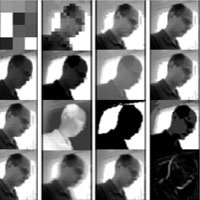Jul 21 2009
Research performed at Caltech as part of a collaborative U.S. Department of Energy-funded artificial-retina project designed to restore sight to the blind has received one of R+D Magazine's 2009 R+D 100 Awards. The prize recognizes significant new technologies that exemplify the most innovative ideas of the previous year.

The artificial retina is a bioelectronic implant that aims to give people with age-related macular degeneration or retinitis pigmentosa-two severe forms of retinal degeneration that lead to blindness-the ability to recognize objects and navigate through their environment. It works via a camera mounted on a pair of glasses, which sends visual information to an implanted electronic receiver.
It is here that Caltech's expertise comes into play. As principal investigator on Caltech's portion of the artificial retina project-which is led by researchers at USC's Keck School of Medicine-Wolfgang Fink, a visiting associate in physics at Caltech and a senior researcher at the Jet Propulsion Laboratory, and Caltech colleague Mark Tarbell have devised and implemented a versatile image-processing software system called the Artificial Retinal Implant Vision Simulator (ARIVS). The ARIVS software system enhances and processes the images captured by the miniature camera in real time according to individually selectable image filters; those ARIVS-processed images are then transmitted to the artificial retina's electrode array.
The electrodes, in turn, stimulate the eye's unharmed retinal ganglion cells, which then transmit their own signals through the optic nerve to the part of the brain known as the visual cortex. From these nerve impulses, the brain creates a visual picture.
To optimize this visual perception, Caltech's Visual and Autonomous Exploration Systems Research Laboratory, under Fink's direction, has also devised and implemented computer algorithms that assist in translating the ARIVS-processed images into useful electrical stimulation of the ganglion cells by means of an iterative process much like that used to determine an eyeglass prescription. Currently, 29 patients have had artificial retina systems implanted as part of clinical trials. The most recent version of the implant features an array of 60 pixels, allowing users to distinguish between light and dark, and see certain distinct objects. The ultimate goal, according to the research team, is to allow for reading and face recognition by increasing the number of pixels to 1,000.
Five national laboratories, four universities, and a private company are involved in the Artificial Retina Project. They are Argonne National Laboratory, Lawrence Livermore National Laboratory, Los Alamos National Laboratory, Oak Ridge National Laboratory, and Sandia National Laboratories, USC (Doheny Eye Institute), Caltech, North Carolina State University, and UC Santa Cruz. The industrial partner, Second Sight Medical Products, Inc., is responsible for commercializing the product and conducting clinical trials.
R+D Magazine has been showcasing new technologies with its R+D 100 Award since 1963. In 2008, Morteza Gharib, the Hans W. Liepmann Professor of Aeronautics and professor of bioengineering at Caltech, received the award for the creation of a three-dimensional camera with a vast array of possibilities, ranging from 3-D movement tracking for rehabilitation to underwater surveillance.
For a full list of the 2009 R+D 100 winners, go to http://www.rdmag.com/awards.html, and to learn more about Fink's Caltech lab, go to http://autonomy.caltech.edu.